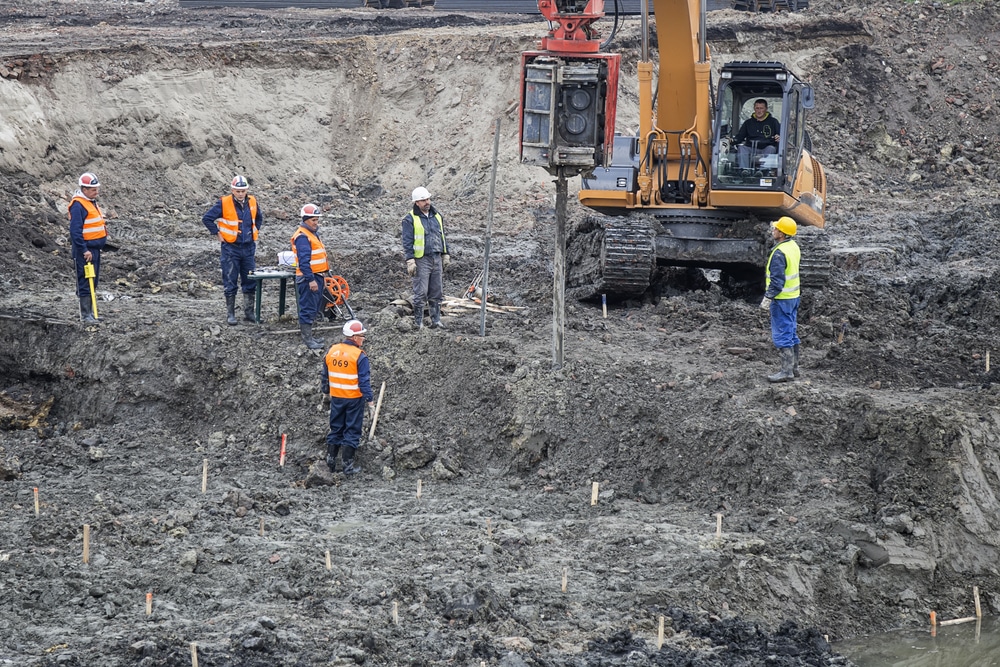The Ultimate Guide To Geotheta
The Ultimate Guide To Geotheta
Blog Article
The Buzz on Geotheta
Table of ContentsThe Buzz on GeothetaUnknown Facts About GeothetaRumored Buzz on GeothetaGeotheta Can Be Fun For Everyone9 Simple Techniques For Geotheta

They carry out website investigations, collect examples, carry out research laboratory tests, and examine data to review the viability of the ground for construction projects - Consulting Engineer. Based upon their findings, geotechnical engineers give suggestions for structure layout, slope security, keeping structures, and mitigation of geotechnical dangers. They collaborate with other experts, such as engineers, architectural designers, and construction groups, to ensure that geotechnical factors to consider are integrated into the general job layout and application
By assessing the actions and homes of dirt and rock, they can identify prospective geotechnical dangers such as landslides, dirt settlement, or incline instability. Their know-how helps stop failings or crashes that might jeopardize lives and property. Right here are some detailed tasks and responsibilities of a geotechnical engineer: Site Examination: Geotechnical designers conduct site examinations to collect data on subsurface conditions.
They analyze the data to understand the homes and actions of the soil and rock, including their stamina, permeability, compaction characteristics, and groundwater problems. Geotechnical Evaluation and Design: Geotechnical designers examine the data accumulated during site investigations to evaluate the security and suitability of the site for construction projects. They carry out geotechnical estimations and modeling to evaluate elements such as bearing ability, negotiation, slope security, side planet stress, and groundwater flow.
The Only Guide to Geotheta
Foundation Layout: Geotechnical engineers play a critical duty in making structures that can safely support the desired structure. They evaluate the dirt problems and tons requirements to establish the appropriate structure type, such as superficial structures (e.g., footings), deep structures (e.g (https://geotheta.wordpress.com/2024/08/02/unlocking-the-secrets-of-geotechnical-engineers-the-geotheta-advantage/)., piles), or specialized strategies like dirt improvement. They consider elements such as settlement limitations, bearing ability, and soil-structure interaction to establish optimum structure designs
They assess building and construction strategies, display site tasks, and perform field inspections to verify that the layout referrals are adhered to. If unexpected geotechnical problems occur, they assess the circumstance and give suggestions for removal or changes to the style. Risk Evaluation and Reduction: Geotechnical engineers assess geotechnical risks and dangers connected with the project site, such as landslides, liquefaction, or soil disintegration.

Partnership and Communication: Geotechnical designers function closely with other experts associated with a job, such as designers, structural designers, and building teams. Effective interaction and cooperation are important to integrate geotechnical considerations right into the general project layout and building process. Geotechnical designers give technical knowledge, response questions, and guarantee that geotechnical requirements are satisfied.
Top Guidelines Of Geotheta
Below are some sorts of geotechnical engineers: Structure Designer: Structure engineers specialize in creating and examining foundations for frameworks. They examine the dirt problems, lots needs, and site features to figure out one of the most proper structure kind and layout, such as superficial structures, deep foundations, or specialized strategies like heap structures.
They evaluate the elements affecting incline security, such as soil residential properties, groundwater conditions, and slope geometry, and establish strategies to stop incline failures and mitigate risks. Earthquake Engineer: Earthquake engineers focus on analyzing and creating structures to stand up to seismic forces. They analyze the seismic threat of a site, evaluate dirt liquefaction possibility, and establish seismic style requirements to make certain the safety and resilience of frameworks throughout earthquakes.
They do field screening, accumulate samples, and evaluate the accumulated information to characterize the dirt residential properties, geologic developments, and groundwater problems at a website. Geotechnical Instrumentation Designer: Geotechnical instrumentation engineers concentrate on surveillance and determining the habits of dirt, rock, and structures. They mount and keep instrumentation systems that monitor factors such as dirt settlement, groundwater levels, incline motions, and structural variations to assess efficiency and offer very early warnings of possible concerns.
Indicators on Geotheta You Need To Know
They carry out tests such as triaxial examinations, loan consolidation tests, straight shear tests, and permeability examinations to gather data for geotechnical evaluation and layout. Geosynthetics Designer: Geosynthetics engineers concentrate on the design and application of look at this now geosynthetic materials, such as geotextiles, geogrids, and geomembranes. They make use of these materials to enhance dirt stability, enhance slopes, provide drainage solutions, and control erosion.
They tend to be investigatory individuals, which suggests they're intellectual, introspective, and investigative. They are interested, systematic, rational, analytical, and sensible. Several of them are additionally social, indicating they're kind, charitable, cooperative, person, caring, useful, empathetic, sensible, and friendly. Does this sound like you? Take our totally free job test to figure out if geotechnical engineer is among your leading job suits.
In the office atmosphere, geotechnical designers utilize specialized software program devices to perform calculations, develop styles, and evaluate data. They prepare reports, review project specifications, connect with customers and staff member, and coordinate project activities. The office setup supplies a conducive environment for study, evaluation, and collaboration with other professionals associated with the job.
Some Known Factual Statements About Geotheta
They frequently see task sites to carry out site examinations, analyze geotechnical conditions, and gather information for analysis. These brows through include taking a trip to different areas, often in remote or challenging surfaces. Geotechnical engineers may execute soil tasting, conduct tests, and display building tasks to ensure that the geotechnical aspects of the project are being executed correctly.
Geotechnical engineers also function in specialized geotechnical research laboratories. In these facilities, they carry out experiments, execute examinations on soil and rock examples, and analyze the design properties of the materials. Geotechnical lab designers function extensively in these atmospheres, taking care of screening equipment, running instruments, and videotaping information. They team up with other lab team to guarantee precise and reputable screening results.
Report this page